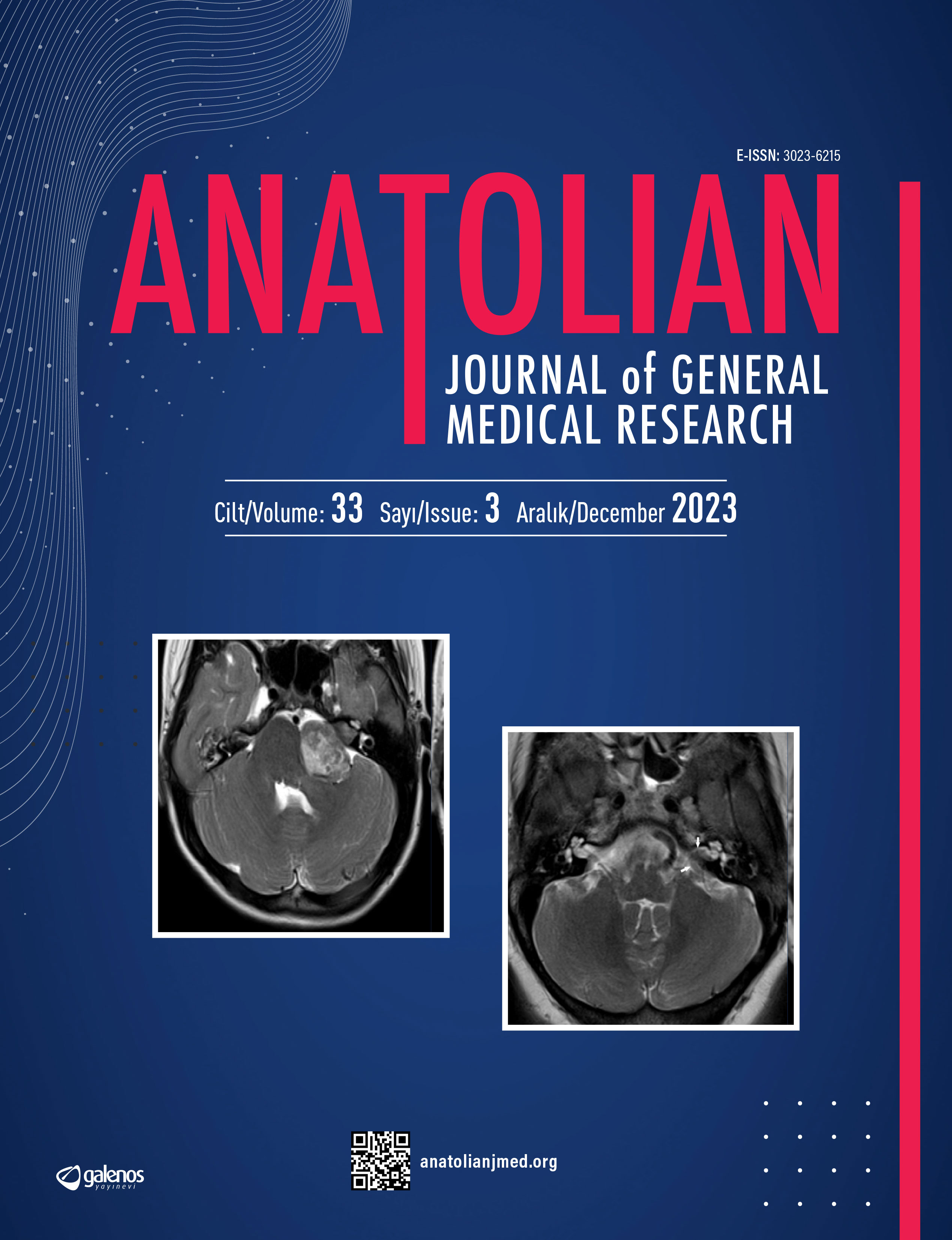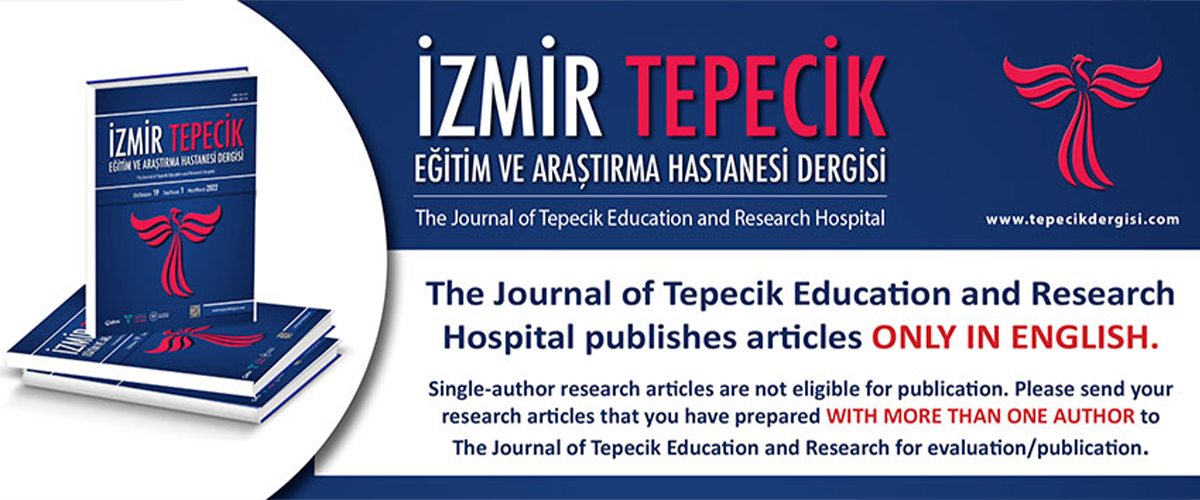








Evaluation of Efficacy of Tigecycline in Non-Purulent Skin and Soft Tissue Infections
Ufuk Sönmez1, Sabri Atalay2, Gürsel Ersan2, Pınar Şamlıoğlu3, Şükran Köse21University Of Health Sciences, Bozyaka Training And Research Hospital, Department Of Infectious Diseases And Clinical Microbiology2University Of Health Sciences, Tepecik Training And Research Hospital, Department Of Infectious Diseases And Clinical Microbiology
3University Of Health Sciences, Tepecik Training And Research Hospital, Department Of Medical Microbiology
INTRODUCTION: Skin and soft tissue infections (SSTI) are common causes of hospitalization and antibiotic use.They can cause a clinical spectrum ranging from localized inflammation to a life-threatening serious clinical picture such as necrosis accompanied by systemic toxicity. The diagnosis of such infections is usually based on clinical findings and treatment is usually empirically initiated. Tigecycline is a semisynthetic glycylcycline which inhibits protein synthesis by binding to the 30S subunit of the ribosome, thus showing bacteriostatic and bactericidal action. Because of its broad spectrum, it is more frequently preferred in mixed bacterial infections.The aim of this study was to evaluate the clinical and laboratory responses and treatment-related side effects of tigecycline in patients with erysipelas and cellulitis.
METHODS: Patients with the diagnosis of non-purulent cellulitis and erysipelas who were unresponsive to oral antibiotic therapy or who could not be treated orally or required hospitalization were included in the study. The diagnosis was made on physical examination with the presence of at least two of erythema, local warming and induration. Patients with purulent SSTI cases, necrotizing infections and diabetic foot cases were not included in the study.
RESULTS: A total of 30 patients were included in the study. The mean age of the patients was 64 (30-84) years. Twenty-seven patients (90%) had at least one underlying chronic disease. In the samples taken from patients with bullous lesions, meticillin-sensitive Staphylococcus aureus (MSSA), Escherichia coli and Enterococcus faecalis growth were in each patient and simultaneously E.coli and MSSA growth in another patient. Clinical response was obtained in all patients except one patient. Nausea and vomiting were observed in one patient and triglyceride elevation in another patient. When laboratory responses were evaluated after one week of tigecycline treatment, a statistically significant response was revaled in leukocyte counts, sedimentation rates and CRP values.
DISCUSSION AND CONCLUSION: In conclusion, tigecycline was found to be effective and safe in non-purulent moderate to severe cases with cellulite-erysipelas.
Pürülan Olmayan Deri ve Yumuşak Doku Enfeksiyonlarında Tigesiklinin Etkinliğinin Değerlendirilmesi
Ufuk Sönmez1, Sabri Atalay2, Gürsel Ersan2, Pınar Şamlıoğlu3, Şükran Köse21Sağlık Bilimleri Üniversitesi, İzmir Bozyaka Eğitim Ve Araştırma Hastanesi Enfeksiyon Hastalıkları Ve Klinik Mikrobiyoloji Kliniği2Sağlık Bilimleri Üniversitesi İzmir Tepecik Eğitim Ve Araştırma Hastanesi Enfeksiyon Hastalıkları Ve Klinik Mikrobiyoloji Kliniği
3Sağlık Bilimleri Üniversitesi İzmir Tepecik Eğitim Ve Araştırma Hastanesi Tıbbi Mikrobiyoloji Kliniği
GİRİŞ ve AMAÇ: Deri ve yumuşak doku enfeksiyonları (DYDE), hastaneye yatış ve antibiyotik kullanımının sık nedenlerindendir. Lokalize inflamasyondan, sistemik toksisitenin eşlik ettiği nekroz gibi hayatı tehdit eden ciddi bir klinik tabloya kadar uzanan bir klinik spektruma neden olabilir. Bu tür enfeksiyonların tanısı çoğunlukla klinik bulgulara dayanarak konulur ve tedavi genellikle ampirik olarak başlanmaktadır. Tigesiklin ribozomun 30S alt birimine bağlanarak protein sentezini inhibe eden, böylece bakteriyostatik ve bakterisidal etki gösteren semisentetik bir glisilsiklindir. Geniş spektrumlu olması nedeni ile daha çok karışık bakteri enfeksiyonlarında tercih edilir. Bu çalışmada tigesiklinin, erizipel ve selülit tanılı hastalardaki klinik ve laboratuvar yanıtının ve tedaviye bağlı yan etkilerinin değerlendirilmesi amaçlanmıştır.
YÖNTEM ve GEREÇLER: Çalışmaya oral antibiyotik tedavisine yanıtsız veya oral tedavi alamayacak olan veya hastaneye yatmayı gerektiren pürülan olmayan selülit ve erizipel tanılı hastalar alınmıştır. Tanı, fizik muayenede eritem, lokal ısı artışı, endurasyon gibi bulgulardan en az ikisinin varlığı ile konulmuştur. Pürülan DYDE olguları olguları, nekrotizan enfeksiyonlar ve diyabetik ayak olguları çalışmaya alınmamıştır.
BULGULAR: Çalışmaya toplam 30 hasta alınmıştır. Hastaların yaş ortalaması 64 (30-84) yıldır. Yirmi yedi hastada (% 90) altta yatan en az bir kronik hastalık mevcuttu. Büllöz lezyonu olan hastalardan alınan örneklerde birer hastada metisiline duyarlı Staphylococcus aureus (MSSA), Escherichia coli ve Enterococcus faecalis, diğer bir hastada da eş zamanlı E.coli ve MSSA üremesi tespit edilmiştir. Tedavi ile bir hasta hariç tüm hastalarda klinik yanıt elde edilmiştir. Tedavi sırasında sadece birer hastada bulantı ve kusma, diğer bir hastada da trigliserid yüksekliği saptanmıştır. Bir haftalık tigesiklin tedavisi sonrası laboratuvar yanıtları değerlendirildiğinde, lökosit sayısı, sedimentasyon hızı ve CRP değerlerinde istatistiksel olarak anlamlı yanıt tespit edilmiştir.
TARTIŞMA ve SONUÇ: Sonuç olarak tigesiklin, pürülan olmayan orta-ciddi seyirli selülit-erizipel olgularında etkili ve güvenilir bulunmuştur.
Corresponding Author: Ufuk Sönmez, Türkiye
Manuscript Language: Turkish
(1683 downloaded)




